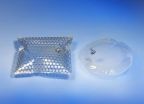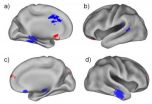(Press-News.org) Films instead of walls. This is an idea that fascinates architects all over the world. The Eden Project in Southern England, the National Aquatics Center built for swimming events at the Olympics in Beijing and the Allianz Arena in Munich are only three examples of what you can make from plastic sheets. Ethylene tetraflourethylene (ETFE), a transparent membrane, is especially popular because it enables buildings that shine in all colors as in Munich and Peking. But, we are not just talking about colors. You can use this new foil for an intelligent improvement of existing buildings – by regulating heat, coolness and light precisely according to needs. Experts see film construction as a market poised for the future.
Whether this market develops and if so how quickly is not a question of taste but of the technical possibilities – the financial options. Films will have to be low-cost, easy to process and free of health hazards for them to have a chance in the international construction business. This is the target that six Fraunhofer institutes are working jointly toward in the Multifunctional Membrane Cushion Construction project.
Engineers have been able to use coatings to change the properties of ETFE foils specifically. For example, membrane cushions with an inner coating of tungsten trioxide turn blue when they come into contact with hydrogen and lose their color if the cushions are filled with oxygen. Thus the passage of light can easily be regulated. Project coordinator Andreas Kaufmann of the Fraunhofer Institute for Building Physics (IBP) states "you could use a foil such as this to cover the entire façade of a house and have light pass depending upon sunlight conditions." The researchers were also able to solve another problem. To date, ETFE membranes have hardly been able to create a heat barrier, but a coat of paper-thin (and therefore transparent) layers of aluminum and paint make sure that heat radiation is effectively reflected. Kaufmann explains that "the challenge was overcoming the anti-adhesive properties of the membrane. ETFE is related to the anti-stick substance Teflon and hardly reacts with other substances chemically. This is why the surface of the foil first has to be pretreated chemically before coating." In the meantime, the researchers have not only come up with heat-insulating, but also antibacterial layers that inhibit the growth of mold and yeasts that form ugly black coverings.
As Robert Hodann, the CEO at film manufacturer Nowofol and industrial partner of the research project, puts it, "we believe that ETFE will emerge as a strong market of its own. The captivating thing about ETFE foil is its transparency combined with its great strength – no other plastic membrane can compete." For instance, it will be possible to make LED façades with ETFE foil behind which thousands of light-emitting diodes can be installed. This would be an easy way to transform facades into gigantic illuminated screens.
INFORMATION:
Films for façades
2010-12-17
ELSE PRESS RELEASES FROM THIS DATE:
Scientists identify the largest network of protein interactions related to Alzheimer's disease
2010-12-17
Through a complex analysis of protein interactions, researchers from IRB Barcelona and the Joint Programme IRB-BSC have discovered new molecular mechanisms that may be involved in the development of Alzheimer's disease. The study, a collaboration between bioinformaticians and cell biologists, was led by IRB Barcelona group leader and ICREA researcher Patrick Aloy and appears today in the Genome Research, a reference journal in the field of genomics.
Alzheimer's disease is an age-related neurodegenerative disease. Despite the considerable efforts made in recent years to ...
It's a pain to take care of pain
2010-12-17
INDIANAPOLIS –While many studies have looked at the treatment of chronic pain from the patient's perspective, there has been little research on those who provide care for chronic pain.
In a study in the November 2010 issue of the journal Pain Medicine, researchers from the Regenstrief Institute, the Indiana University School of Medicine, the IU School of Liberal Arts and the Roudebush VA Medical Center report that chronic pain takes a toll on primary care providers as well as their patients. They conclude that providers' needs should not be ignored if pain care is to ...
Information technology needs fundamental shift to continue rapid advances in computing and help drive US competitiveness
2010-12-17
WASHINGTON — The rapid advances in information technology that drive many sectors of the U.S. economy could stall unless the nation aggressively pursues fundamental research and development of parallel computing -- hardware and software that enable multiple computing activities to process simultaneously, says a new report by the National Research Council. Better options for managing power consumption in computers will also be essential for continued improvements in IT performance.
For many decades, advances in single-processor, sequential computer microprocessors have ...
URI geologist develops improved seismic model for monitoring nuclear explosions in Middle East
2010-12-17
KINGSTON, R.I. – December 16, 2010 – Geologists from the University of Rhode Island and Princeton University, in collaboration with Lawrence Livermore National Laboratory, have taken an important step toward helping the United States government monitor nuclear explosions by improving a 3-dimensional model originally developed at Harvard University. The improvements make the model more accurate at detecting the location, source and depth of seismic activity.
The results of their research were presented today at a meeting of the American Geophysical Union in San Francisco.
The ...
Flu on the western front
2010-12-17
The World Health Organization set a target for the influenza vaccination rate for 2006 of more than 50% of the elderly population and an increase to more than 75% by 2010. These rates have thus far not been achieved in the old German states. In the current issue of Deutsches Ärzteblatt International (Dtsch Arztebl Int 2010; 107[48]: 845) the working group around Annicka M. Reuss presents rates from flu seasons past.
Germany's Standing Vaccination Committee (STIKO) recommends annual vaccinations against seasonal influenza. The risk groups for the infection, which ...
New study suggests almonds may help reduce risk of type 2 diabetes and heart disease
2010-12-17
Modesto, CA (Dec. 16, 2010) – With nearly 16 million Americans living today with prediabetes, a condition that is the precursor to type 2 diabetes, and half of all Americans expected to have either prediabetes or type 2 diabetes by the year 2020, nutritional approaches to maintaining healthy blood sugar levels are essential.1,2 The findings of a scientific study examining the health promotion and disease prevention benefits of almond consumption were published in the June, 2010 Journal of the American College of Nutrition. The study, one of the first of its kind to quantify ...
Decades after childhood radiation, thyroid cancer a concern
2010-12-17
When children are exposed to head and neck radiation, whether due to cancer treatment or multiple diagnostic CT scans, the result is an increased risk of thyroid cancer for the next 58 years or longer, according to University of Rochester Medical Center research.
The study is believed to be the longest of any group of children exposed to medical irradiation and followed for thyroid cancer incidence. It was published in the December 2010 edition of the journal, Radiation Research.
The data also might provide some insight about why the rates of thyroid cancer continue ...
Wind turbines may benefit crops
2010-12-17
AMES, Iowa – Wind turbines in Midwestern farm fields may be doing more than churning out electricity. The giant turbine blades that generate renewable energy might also help corn and soybean crops stay cooler and dryer, help them fend off fungal infestations and improve their ability to extract growth-enhancing carbon dioxide [CO2] from the air and soil.
Speaking at the annual meeting of the American Geophysical Union, a scientific society, in San Francisco today, a researcher at the U.S. Department of Energy's Ames Laboratory and his co-researcher from the University ...
Teacher effort is linked to difficult students' inherited traits
2010-12-17
Challenging students take up more of their teachers' time—and the difference between a tougher student and an easier one appears to be genetic, according to a new study published in Psychological Science, a journal of the Association for Psychological Science. The study looked at young twins in the U.K. and asked their teachers how much of a handful they are.
"Policy-wise, there's a lot going on, blaming teachers for what's going on in the classrooms," says Renate Houts of Duke University, who cowrote the study with Avshalom Caspi and Terrie E. Moffitt of Duke, Robert ...
MRI scans reveal brain changes in people at genetic risk for Alzheimer's
2010-12-17
AUDIO:
People with a known risk for Alzheimer’s disease seem to develop abnormal brain function even before the appearance of amyloid plaques in the brain. A new study from Washington University...
Click here for more information.
People with a known, high risk for Alzheimer's disease develop abnormal brain function even before the appearance of telltale amyloid plaques that are characteristic of the disease, according to a new study.
Researchers at Washington University ...


